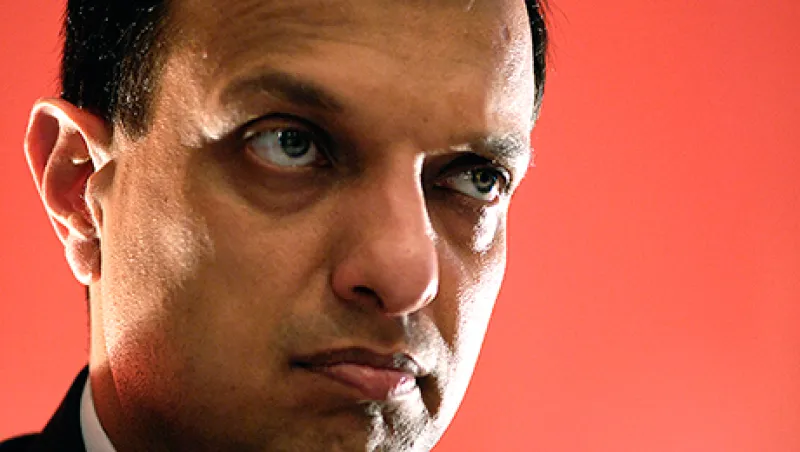Late last year Indian Prime Minister Narendra Modi vowed to end “financial untouchability” in his country and bring basic financial services to hundreds of millions in need. Now an effort led by Nachiket Mor, a director on the central board of the Reserve Bank of India, is taking Modi’s vision one step closer to reality.
In the next year and a half India will witness a rollout of so-called payments banks — nonbank institutions authorized to take deposits and transfer funds but restricted from lending and other traditional banking services — that promise to use their existing distribution channels to touch the country’s unbanked population.
Being poor is expensive. Throughout emerging markets the unbanked turn to cash, livestock, jewelry, and other easily lost and stolen items to store their wealth. In 2014 only 53 percent of Indian adults had a bank account, according to the World Bank Group. Those without access to financial services often have no recourse to credit or face exorbitant interest rates, pushing them deeper into poverty when they take a financial hit.
That’s changing in India. In recent years the government has taken ambitious steps to pull its poor and rural households into the country’s financial system so the un- and underserved can tap efficient methods of preserving and growing their wealth, giving them a better shot at climbing out of poverty.
In late 2013, with the goal of evaluating various methods of promoting financial inclusion, the RBI created the Committee on Comprehensive Financial Services for Small Businesses and Low Income Households, with Mor presiding as chair over such big-name bankers as Vikram Pandit, former CEO of Citigroup, and Shikha Sharma, managing director and CEO of Axis Bank, India’s third-largest private sector bank.
In January 2014 what is commonly called the Nachiket Mor Committee released a comprehensive report recommending payments banks as one solution to the problem. These nonbank institutions would be allowed to issue debit cards, accept deposits, and facilitate digital payments and the transfer of funds. Although restricted from engaging in many traditional banking services, payment banks could function as a conduit for third parties to offer products such as loans, credit cards and insurance.
A self-proclaimed “development enthusiast,” Mor, 55, has been familiar with village economies since his upbringing in a farming family in western India. He studied hard; after receiving his MBA from the Indian Institute of Management, he worked with mushroom growers in central India for PRADAN, a New Delhi–based nongovernmental organization.
Mor moved to ICICI Bank — then a development bank but now India’s biggest private sector bank — in 1987. He left for the U.S. three years later to pursue a doctorate in finance at the University of Pennsylvania. After receiving his Ph.D. in 1994, he returned to ICICI, where he rose to become deputy managing director before departing in 2007 to head the firm’s newly formed ICICI Foundation for Inclusive Growth and concentrate on rural development.
Most recently Mor joined the Bill & Melinda Gates Foundation as a senior adviser in September. Although his main focus will be advising the foundation’s health care programs, his private sector and regulatory experience will be an invaluable resource to the Financial Services for the Poor (FSP) initiative as it works to support the burgeoning payments banking industry, says Daniel Radcliffe, a Seattle-based senior program officer. “He’s quite the multipronged thinker,” Radcliffe observes.
Mor’s extensive experience in the banking sector and insights into rural development drew him to the government’s financial inclusion agenda after he was appointed to the RBI’s central board in May 2013. Following his committee’s report he chaired the external advisory group tasked with evaluating the applications to establish payments banks.
Under his leadership the committee reviewed 41 submissions and issued 11 preliminary licenses to a collection of telecommunications operators, conglomerates, information technology developers and nonbank financial services providers. Those chosen have 18 months to meet a list of requirements before receiving a full license to begin operations.
Prime Minister Modi’s administration showed its commitment to opening up the banking system when it launched a campaign, called Pradhan Mantri Jan Dhan Yojana, in August 2014 to expand access to savings accounts, remittance, credit, insurance and retirement accounts.
The scheme called for the creation of 75 million new bank accounts — though no deposit was required — by the following January. Almost 189 million new accounts have been opened since the drive started, about 60 percent of them belonging to people in rural areas, according to the Ministry of Finance. Nearly 40 percent of all accounts remain empty, though.
As impressive as that rapid increase is, one major problem persists: lack of infrastructure in rural communities. In those villages where traditional banks have yet to establish branches, new account holders may have to travel several miles, often on foot, to make deposits or withdrawals. This physical barrier between rural dwellers and their cash is preventing many of the newly opened accounts from being used.
“What we need here are providers who see a real business case in establishing infrastructure in every village of the country,” the Gates Foundation’s Radcliffe explains. The payments bank model seeks to leverage the existing physical presence of nonbank organizations in parts of the country not reached by traditional banks. For example, three of the companies to receive preliminary licenses are telecommunications providers that could develop mobile money applications, immediately reaching all of their current cell phone subscribers in India’s countryside.
Hoisting rural India out of poverty is a daunting task with or without payments banks in the mix, but Radcliffe stresses that the government’s trial-and-error approach could serve as a road map for developed as well as emerging nations. “We see India as being not only a powerful demonstration case for improving government through payment connections but also a powerful model for how the public sector can create shared infrastructure that unlocks so much potential,” he says.






